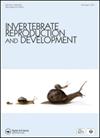盘状环节动物Tubifex Tubifex的产卵行为:实验室培养条件下成熟蠕虫的视频记录
IF 0.8
4区 生物学
Q4 REPRODUCTIVE BIOLOGY
引用次数: 0
摘要
摘要本研究采用录像的方法,观察了试管虫(Tubifex Tubifex)的产卵过程。在第11节和第12节的阴囊周围形成柠檬形的茧后,储存在12 - 14节的卵面中的成熟卵开始通过茧的收缩后端进入11 - 12节。在一秒钟左右的时间内,卵从后缘出来,回到后节。这样的运动要重复几次,卵才会在第11节的卵巢体腔内沉淀下来。在卵子进入卵巢体腔的几秒钟内,阴蒂区域的轮廓开始轻微改变;看起来好像有什么圆形的东西在敲打这个区域的体腔壁。当这种敲击停止时,体腔卵开始移动到茧和阴蒂之间的空间。体腔卵分别从靠近茧中点的雌性性腺孔中挤出。这个过程被称为鸡蛋沉积,在30秒内完成。卵沉积之后,茧的前段向后取出。本文章由计算机程序翻译,如有差异,请以英文原文为准。
Oviposition behaviour in the clitellate annelid Tubifex tubifex: video recordings of mature worms under laboratory culture conditions
ABSTRACT In the present study, videos were recorded to observe oviposition in living, mature worms of Tubifex tubifex. After the formation of a lemon shaped cocoon around the clitellum at segments 11 and 12, mature eggs that have been stored in the ovisac at segments 12–14 begin to move into segments 11–12 through the constricted posterior end of the cocoon. Within a second or so, ovisac eggs emerge out of the posterior margin and return to the posterior segments. Such movements are repeated several times before the ovisac eggs settle in the ovarian coelom of segment 11. Within a few seconds of the eggs moving into the ovarian coelom, the clitellar region begins to change its contour slightly; it looks as if something round is tapping on the coelomic wall of this region. As this tapping ceases, the coelomic eggs begin to move to the space between the cocoon and the clitellum. Coelomic eggs are individually squeezed out of the female gonopores located near the midpoint of the cocoon. This process, referred to as egg deposition, is accomplished within 30 s. The egg deposition is followed by the backward withdrawal of the anterior segments from the cocoon.
求助全文
通过发布文献求助,成功后即可免费获取论文全文。
去求助
来源期刊
CiteScore
1.90
自引率
0.00%
发文量
21
审稿时长
>12 weeks
期刊介绍:
Invertebrate Reproduction & Development ( IRD) presents original research on the reproductive and developmental biology of the Invertebrata, both embryonic and postembryonic. IRD welcomes papers reporting significant results obtained using new techniques. Encouraged topic areas include: aquaculture, physiology, biochemistry, functional morphology, phylogeny, behavioural and regulatory mechanisms, including genetic, endocrine and molecular studies. Papers containing qualitative descriptions of reproductive cycles and gametogenesis will not be considered. IRD is published in association with the International Society of Invertebrate Reproduction and Development.

 求助内容:
求助内容: 应助结果提醒方式:
应助结果提醒方式:


